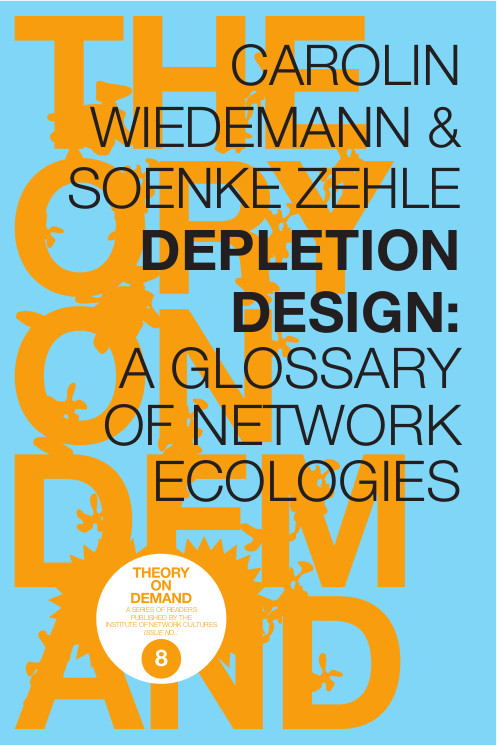Carolin Wiedemann, Soenke Zehle (eds.): Depletion Design: A Glossary of Network Ecologies (2012)
Filed under book | Tags: · algorithm, anonymous, architecture, biopolitics, commons, creative industries, cyborg, design, ecology, hackerspace, media ecology, network ecology, networks, politics, remix, software, spam, technology, theory

“Depletion Design suggests that ideas of exhaustion cut across cultural, environmentalist, and political idioms and offers ways to explore the emergence of new material assemblages. Soenke Zehle and Carolin Wiedemann discuss Depletion Design with Marie-Luise Angerer, Jennifer Gabrys and David M. Berry, inviting tm13 participants into a collaborative reflection on the necessity to understand human beings as one species among others – constituted by interactions of media, organisms, weather patterns, ecosystems, thought patterns, cities, discourses, fashions, populations, brains, markets, dance nights and bacterial exchanges (Angerer); on the material leftovers of electronics as provocations to think through and rework practices of material politics that may be less exploitative within our natural-cultural relationships (Gabrys); and on lines of flight from and through the computational – about expanding them into new ways of living beyond current limitations and towards new means of judgment and politics (Berry).
We, or so we are told, are running out of time, of time to develop alternatives to a new politics of emergency, as constant crisis has exhausted the means of a politics of representation too slow for the state of exception, too ignorant of the distribution of political agency, too focused on the governability of financial architectures. But new forms of individual and collective agency already emerge, as we learn to live, love, work within the horizon of depletion, to ask what it means to sustain ourselves, each other, again. Of these and other knowledges so created, there can no longer be an encyclopedia; a glossary, perhaps.”
Contributors: Marie-Luise Angerer (Cyborg), Franco ‘Bifo’ Berardi (Exhaustion, Soul Work), David M. Berry (On Terminality), Zach Blas (Queer Darkness), Drew S. Burk (Grey Ecology), Gabriella Coleman (Anonymous), Heidi Rae Cooley (Ecologies of Practice), Sebastian Deterding (Playful Technologies, Persuasive Design), Jennifer Gabrys (Natural History, Salvage), Johannes Grenzfurthner & Frank A. Schneider (Hackerspace), Eric Kluitenberg (Sustainable Immobility), Boyan Manchev (Disorganisation, Persistence), Lev Manovich (Software), Sonia Matos (Wicked Problems), Timothy Morton (Ecology without Nature), Jason W. Moore (Crisis), Anna Munster (Digital Embodiment), Eduardo Navas (Remix[ing] Re/Appropriations), Brett Neilson (Fracking), Sebastian Olma (Biopolitics, Creative Industries, Vitalism), Luciana Parisi (Algorithmic Architecture), Jussi Parikka (Dust Matter), Judith Revel (Common), Ned Rossiter (Dirt Research), Sean Smith (Information Bomb), Hito Steyerl (Spam of the Earth)
Publisher Institute of Network Cultures, Amsterdam, Dec 2012
Theory on Demand series, 8
Creative Commons Attribution-NonCommercial-ShareAlike 3.0 Netherlands License
ISBN 9789081857512
via jussiparikka.net
PDF, PDF (updated on 2015-7-9)
Comment (0)Jeffrey Saletnik, Robin Schuldenfrei (eds.): Bauhaus Construct: Fashioning Identity, Discourse and Modernism (2009)
Filed under book | Tags: · architecture, art, bauhaus, copyright, critical theory, design, painting, photography

Reconsidering the status and meaning of Bauhaus objects in relation to the multiple re-tellings of the school’s history, this volume positions art objects of the Bauhaus within the theoretical, artistic, historical, and cultural concerns in which they were produced and received.
Contributions from leading scholars writing in the field today – including Frederic J. Schwartz, Magdalena Droste, and Alina Payne – offer an entirely new treatment of the Bauhaus. Issues such as art and design pedagogy, the practice of photography, copyright law, and critical theory are discussed. Through a strong thematic structure, new archival research and innovative methodologies, the questions and subsequent conclusions presented here re-examine the history of the Bauhaus and its continuing legacy. Essential reading for anyone studying the Bauhaus, modern art and design.
Publisher Routledge, an imprint of Taylor & Francis, 2009
ISBN 0415778360, 9780415778367
304 pages
Franz Schulze: Mies van der Rohe: A Critical Biography (1985/1989) [Italian]
Filed under book | Tags: · architecture, bauhaus, biography, design

Schulze’s acclaimed biography is the first full treatment of the master German-American modern architect. Schulze traces Mies’s European career in its progression to avant-garde modernism—where his work was materially rich but of modest scale—to his second maturity and world renown in the United States, where he invented a new architectural language of “objective” structural expression. Among the authors’ most exciting new discoveries is the massive transcript of the early-1950s Farnsworth House court case, which discloses for the first time the facts about Mies’s epic battle with his client Edith Farnsworth. The book reveals new information about his relationships with women, including the nature and breakup of his marriage to the wealthy Ada Bruhn, his close professional and personal ties to the gifted designer Lilly Reich, and new details from a series of illuminating interviews with his American companion, Lora Marx. This edition also gives voice to dozens of architects who knew and worked with (and sometimes against) Mies—many of them from the unique oral history collection of the Art Institute of Chicago’s Department of Architecture.
This comprehensive biography tells the compelling story of how Mies and his students and followers created some of the most significant buildings of the twentieth century.
Originally published by University Of Chicago Press, in association with the Mies van der Rohe Archive of the Museum of Modern Art, 1985
Translated to Italian by Mara De Benedetti, published as Mies van der Rohe by Editorial Jaca Book spa, Milan, April 1989, ISBN 8816600888, 344 pages.
PDF (no OCR)
Comment (0)
